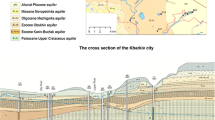Abstract
Kopaida plain is a cultivated region of Eastern Greece, with specific characteristic related with the paleogeographic evolution and the changes in land use. The present article examines the contamination that derives from nitrates, in terms of contaminant levels, definition of sources and spatial distribution of contaminant plume. For this purpose, 50 water samples were collected from the karstic aquifer and analyzed for 15 parameters including major ions, trace elements, physicochemical parameters, and stable isotopes. The assessment of the above parameter values along with the notes derived by the statistical process revealed the existence of nitrate contamination which has been spatial defined with the aid of spatial interpolation techniques. The correlation of NO3 − concentrations with the stable isotope values, defined the infiltration conditions and showed contaminant transport. Nitrate values revealed the potential environmental threat for local people, as 10% of the samples exceeded the parametric value of 50 ppm and 54% of them are above 25 ppm, indicating no optimal quality conditions. The origin of nitrate contamination seems to derive exclusively from the application of N-fertilizers, since the rest of potential sources were not verified by analytical data and field works.







Similar content being viewed by others
References
Allen HD (1986) Late quaternary of the Kopais Basin, Greece: sedimentary and environmental history. PhD Thesis, University of Cambridge
Appelo C, Postma D (2005) Geochemistry, groundwater and pollution, 2nd edn. A.A. Balkema Publishers, The Netherlands
Benefield LD, Judikins JF, Weand BL (1982) Process chemistry for water and wastewater treatment. Prentice Hall Inc., New Jersey
Burrough PA (1986) Principles of geographical information systems for land resources assessment. Oxford Univ. Press, Oxford
Chriss RE, Davisson ML (1996) Isotope imagining of surface water/groundwater, Sacramento valley, California. J Hydrol 178(1–4):205–222
Datta PS, Deb DL, Tyagi SK (1997) Assessment of groundwater contamination from fertilizers in the Delhi area based on 18O, NO3 and K+ composition. J Contam Hydrol 7:249–262
Davisson ML, Criss RE (1993) Stable isotope imaging of a dynamic groundwater system in the southwestern Sacramento valley, California (USA). J Hydrol 144:213–246
European Water Directive (2000) Directive 2000/60/EC of the European Parliament and of the Council of 23 October 2000 establishing a framework for community action in the field of water policy
Fennesy MS, Cronk JK (1997) The effectiveness and restoration potential of riparian ecotones for the management of non-point source pollution, particularly nitrate. Crit Rev Environ Sci Technol 27:285–317
Gascoyne M (1997) Evolution of redox conditions and groundwater composition in recharge-discharge environments on the Canadian shield. Hydrogeol J 5(3):4–18
Hallberg GB (1989) Nitrate in groundwater in the United States. In: Follet RF (ed) Nitorgen manangementgroundwater protection < developments in agricultural and managed forests ecology, vol 21. Elsevier, New York, pp 35–74
Hem J (1985) Study and interpretation of the chemical characteristics of natural water. U.S. Geological Survey, Water Supply Paper 2254
Horiefka J (2008) Spatial interpolation and terrain analysis. Geoinformation Technology for Geo-Cultural Landscape Analysis, Francis and Taylor (in print)
Hounslow A (1995) Water quality data: analysis and interpretation. Lewis Publishers CRC Press, 397 pp
Joanes DN, Gill CA (1998) Comparing measures of sample skewness and kurtosis. J Roy Stat Soc D 47(1):183–189
Kim J, Kim R, Lee J, Chang H (2002) Hydrogeochemical characterization of major factors affecting the quality of shallow groundwater in the coastal area at Kimje in South Korea. Env Geol 44:189–478
Lam SN (1983) Spatial interpolation methods: a review. Am Cartogr 10:129–149
Lang YC, Liu CQ, Zhao ZQ, Li SL, Han GL (2006) Geochemistry of surface and groundwater in Guiyang, China: water/rock interaction and pollution in a karst hydrological system. Appl Geochem 21:887–903
Lovely D (1997) Microbial Fe(III) redox in subsurface environments. FEMS Microbial Rev 20:205–313
Mikkelsen SA (1992) Current nitrate research in Denmark—background and practical application, nitrate and farming systems. Appl Biol 30:29–44
Mitas L, Mitasova H (1999) Spatial interpolation. In: Longley P, Goodchild MF, Maguire DJ, Rhind DW (eds) Geographical information systems: principles, techniques management and applications, geoinformation international. Wiley, New York, pp 481–492
Pacheco J, Marin L, Cabrera A, Steinich B, Escolero O (2001) Nitrate temporal and spatial patterns in 12 water-supply wells, Yucatan, Mexico. Env Geol 40:708–715
Pagounis M, Gkertzos T, Gkatzoyianns A (1994) Hydrogeological study of Viotikos Kifisos basin. Technical report, I.G.M.E. (in Greek)
Panda UC, Sundaray SK, Rath P, Nayak BB, Bhatta D (2006) Application of factor and cluster analysis for characterization of river and estuarine water systems—a case study: Mahanadi River (India). J Hydrol 331:434–445
Piskin R (1973) Evaluation of nitrate content of groundwater in Hall County, Nebraska. Groundwater 11(6):4–13
Rajmohan N, Elango L (2005) Nutrient chemistry of groundwater in an intensively irrigated region of southern India. Env Geol 47:820–830
Reinmann C, Filzmoser P (2000) Normal and lognormal distribution in geochemistry: death of a myth. Consequences for the statistical treatment of geochemical and environmental data. Env Geol 39(9):1001–1014
Ritter W, Chrinside A (1984) Impact of land use on groundwater quality in southern Delaware. Groundwater 22:38–47
Shrimaly M, Singh K (2001) New methods of nitrate removal from water. Environ Pollut 112:351–359
Tziritis EP, Kelepertzis A, Stamatakis MG (2008) Hydrogeochemical and environmental conditionsof East Kopaida-Yliki karst groundwater system. In: 8th International hydrogeological congress, Athens-Greece, 2nd vol, pp 733–742
Author information
Authors and Affiliations
Corresponding author
Rights and permissions
About this article
Cite this article
Tziritis, E.P. Assessment of NO3 − contamination in a karstic aquifer, with the use of geochemical data and spatial analysis. Environ Earth Sci 60, 1381–1390 (2010). https://doi.org/10.1007/s12665-009-0274-3
Received:
Accepted:
Published:
Issue Date:
DOI: https://doi.org/10.1007/s12665-009-0274-3




